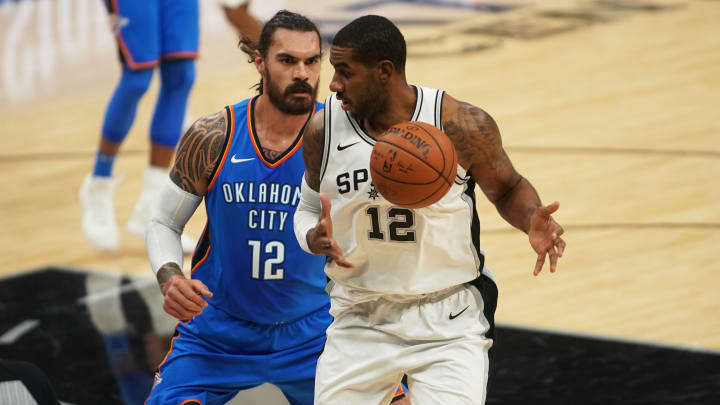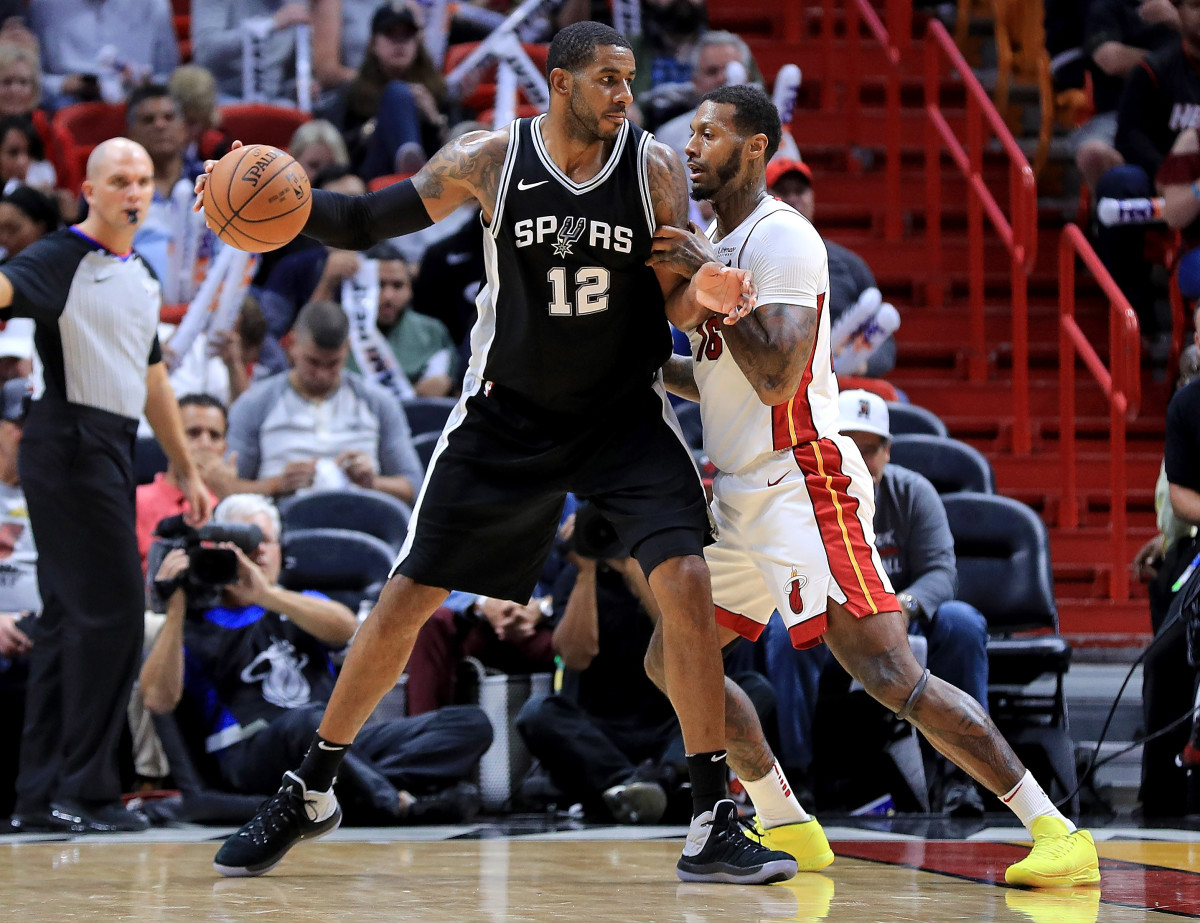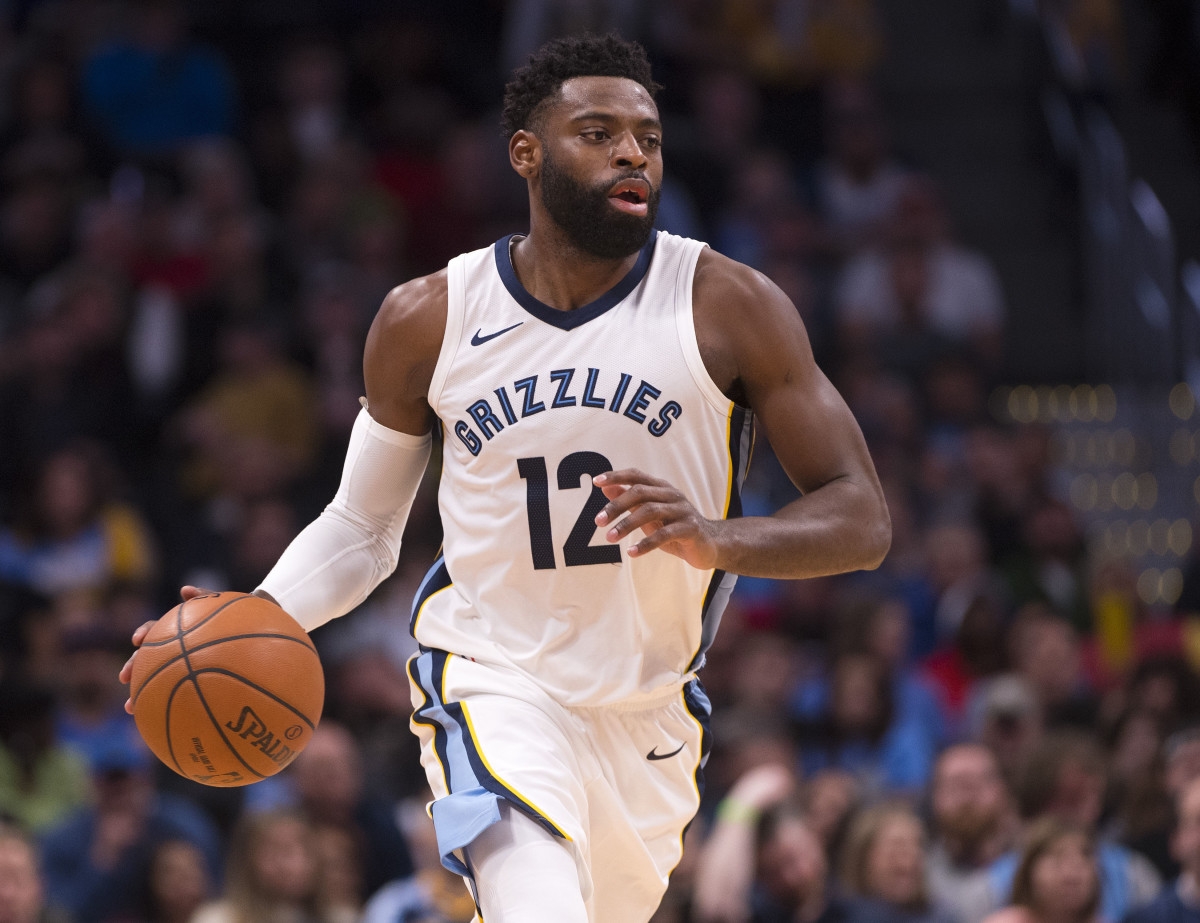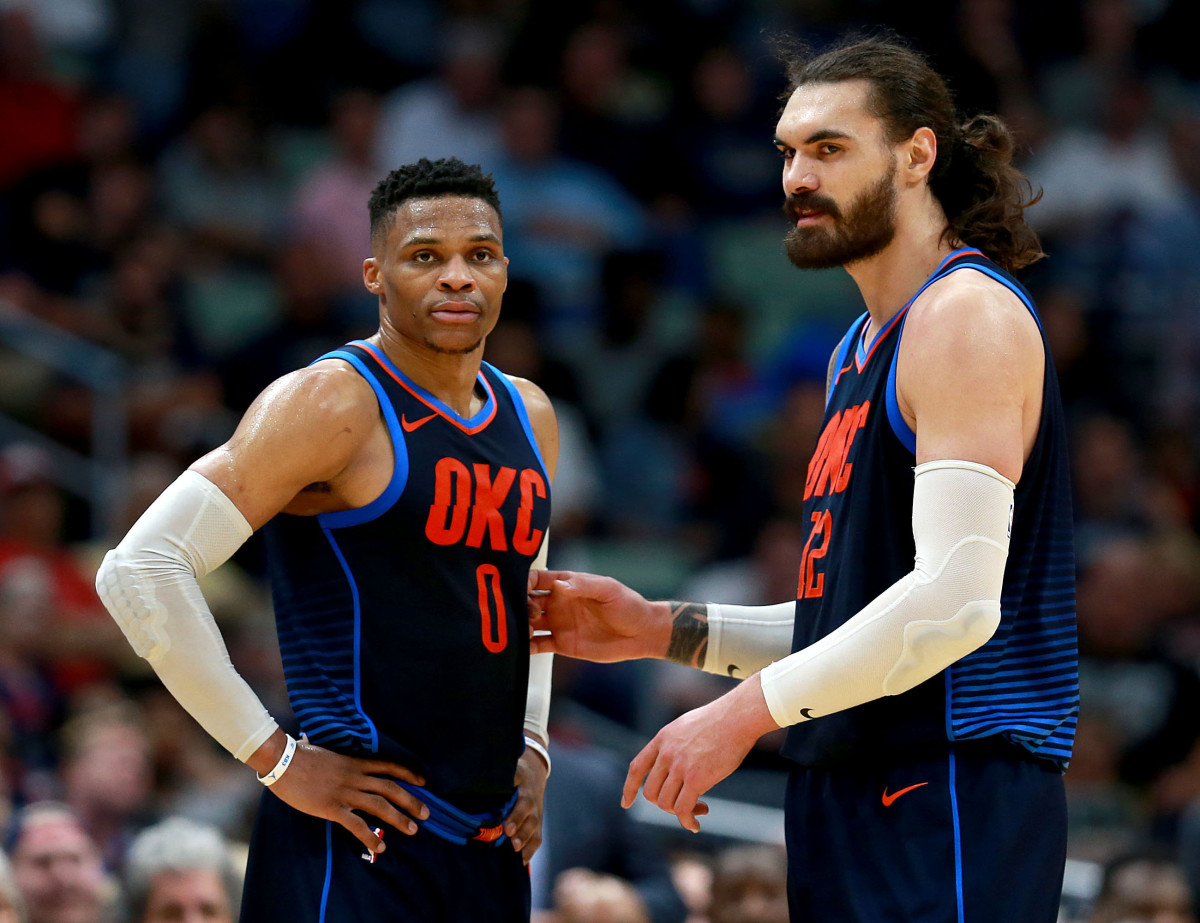Alternative NBA Awards: Highlighting the Underrated Facets of the Game

With the end of the regular season comes an auspicious occasion: the chance, per long-standing internet practice, to hand out entirely made-up awards. Below are a handful of honors designed to highlight what the NBA’s standard array fails to recognize.
Without further ado...

Post Stalwart of the Year: LaMarcus Aldridge, Spurs
What an abject disaster this Spurs season could have been if not for Aldridge. San Antonio’s roster was built with a precarious balance that relied on Kawhi Leonard most of all. That Leonard played all of nine games should have been the Spurs’ undoing. Enter Aldridge, who had been promised a steadier role in the offense but found himself at the fulcrum. If Aldridge couldn’t manufacture enough offense to carry the team, things would sputter in the hands of even lesser creators.
So the Spurs worked the ball through the post, all without the kind of shooting that would properly support it. To cull efficient offense from the post in the modern NBA requires nearly a perfect intersection of factors: elite post skill, good offensive tempo, consistent entry passing, and impeccable spacing. San Antonio couldn’t often check all the boxes, but Aldridge made it work. Running so much offense through Aldridge all but guaranteed a decent shot; Aldridge only turns the ball over on an astounding 6% of his possessions in the post, according to Synergy Sports, and he converts 47% on his shots from that premise. It’s to his credit that the Spurs maintained a pretty average offense—quite an achievement considering that the team’s second-leading scorer (Rudy Gay) averaged 11.6 points per game.
Ultramarathon Medalists:
Gold: C.J. McCollum, Blazers
Silver:Jrue Holiday, Pelicans
Bronze: Bradley Beal, Wizards
Only three players in the league* have covered 200 miles of in-game distance this season, per NBA.com, a testament to both their physical endurance and their commitment to off-ball movement. McCollum (215.3 miles) is a titan of this particular metric; he’s led the league in total mileage in each of the last three seasons by running spiraling routes into hand-offs and pick-and-rolls. Holiday (211.1 miles) covered more ground on defense this season than any player has in the five-year history of the NBA’s optical tracking, all while sharing creative responsibility for the Pelicans’ offense. Beal’s third-place finish is really a testament to the Wizards’ style of play in the absence of John Wall. Washington could have put the ball in Beal’s hands and asked him to create everything. Instead, the Wizards entrusted players like Otto Porter and Tomas Satoransky to do a bit more than usual, maintaining the basic structure of the offense and allowing Beal (200.6 miles) room to make his catches on the move.
All three of these players are exceptional athletes, even if they might not fit the usual criteria.
*It’s worth noting that, by season’s end, Ben Simmons and Paul George will likely have crossed the 200 mile threshold.
Gunner of the Year: Zach LaVine, Bulls
When LaVine returned to action back in January, he came out shooting. It took all of 37 seconds for him to get up his first shot attempt after sitting the better part of a year: a curling, 27-foot three-pointer that the Bulls had laid out for him:
So began a campaign of understandable excess. LaVine is a prolific scorer on a team that has few; Chicago will likely finish the season with one of the three worst offenses in the league this season, in part because so many of the team’s regulars are still figuring out how to best create shots. Letting LaVine experiment on the job made sense for all involved. The only way back for LaVine, who tore his ACL in February of 2017, was through pushing gradually until his knee gave him the stability he needed to feel comfortable again. It should come as little surprise that LaVine used shooting as a diagnostic.
It took all of 656 minutes for LaVine to hoist up 355 shot attempts, good for 20 shots every 36 minutes. That might not seem especially gaudy until you realize that Russell Westbrook, who leads the league in shots per minute this season, takes 21 attempts per 36 minutes. Here is an incomplete list of players who shoot less often than LaVine: LeBron James; Kevin Durant, Stephen Curry, and Klay Thompson; Anthony Davis; Giannis Antetokounmpo; Damian Lillard and C.J. McCollum; Victor Oladipo; Donovan Mitchell; DeMar DeRozan; Paul George; and Bradley Beal… along with all but eight other NBA players. Where LaVine is unique among the NBA’s foremost gunners this season was, unfortunately, in the results. LaVine ultimately got his, though in getting there shot 38% from the field. His commitment to getting buckets—with little regard for his shooting struggles—is kind of admirable.
Most Charged: Marreese Speights, Magic
Speights took home this same award last year after accepting the charge as a way of life. That simple act gave him a way to actually contribute on defense. Speights doesn’t have helpful instincts, quick feet, or much of a knack for contesting shots, leaving him without recourse on many defensive possessions. Taking charges gave him a certain focus. The act is so small and so specific that Speights could quickly learn to perfect it. All he had to learn was when and how to get in the way.
The act of taking a charge is an all-or-nothing proposition, which is a dramatic upgrade over the nothing-or-nothing proposition of Speights’s usual defense. Everyone on the floor understands that it’s Speights’s shooting that keeps him in the game, while his performance on the other side of the floor is largely tolerated. Yet even as opponents look to pick on Speights in the pick-and-roll, they now have to be fully conscious of where and how he’s positioned. The frequency with which he’s able to bait drivers and roll men into running straight through him is ridiculous. The other contenders for this award are mainstays on the drawn charge leaderboard: Ersan Ilyasova, Kyle Lowry, and DeMarcus Cousins. Yet Speights won easily by drawing charges at nearly double the rate.

Best High-Usage Lineup: Philadelphia 76ers
Philadelphia’s starting five: Ben Simmons, Joel Embiid, J.J. Redick, Robert Covington, and Dario Saric (+21.4 points per 100 possessions)
What made the idea of Simmons so tantalizing was the variety with which he could be deployed. The reality has been even more powerful, in large part because Simmons is already one of the league’s better all-around defenders. With that flexibility, the Sixers could throw out their best five players and suss out whatever matchups made sense. Covington can usually cover any opponent Simmons cannot, and Redick slides in to chase shooters when Simmons’s talents can be put to better use elsewhere. This is a stifling defense couched in one of the most out-and-out talented offensive lineups in the league. Imagine what terrors they’ll be capable of when the stars involved are actually in their primes.
Worst High-Usage Lineup: Chicago Bulls
Chicago’s tank machine: Kris Dunn, Lauri Markkanen, Denzel Valentine, Justin Holiday, and Robin Lopez (-5.9 points per 100 possessions)
The Pistons had a shot at a repeat here, but their most disastrous high-usage lineup was dismantled at the trade deadline. That leaves the Bulls with the honor, as they had enough roster consistency this season to actually play this lineup over 500 minutes on their way to one of the league’s worst records. It’s three young players learning the ropes of running an offense in real time, flanked by two veterans who help in ways that are subtle enough to not damage the franchise’s ultimate goal. Maybe that makes this one of the best—or at least the most effective— lineups?

Most Promising Reclamation Project: Tyreke Evans, Grizzlies
What a year it’s been for Evans, who played so well in Memphis that the Grizzlies—who had no incentive to win—reportedly balked at the thought of trading their minimum-salary veteran for two second-round picks. Evans walked into the season with manageable expectations and played to the fullest effect, averaging 19 points, five rebounds, and five assists per game. This was his most productive season since 2010. And if the distance between those two high-water marks didn’t make Evans’s resurgence improbable enough, the many injuries in between should certainly do the trick. Much of the league had written Evans off, which, ironically, is the only reason he was able to land with the Grizzlies and prove the error in that thinking.
Evans has his limitations as a player, but one of his most glaring from previous seasons appears to be rectified: after shooting 30% from beyond the arc in his first seven years in the league, Evans made 40% of his threes for the Grizz. That discrepancy invites some skepticism, though there’s enough material change to Evans’s release and a growing body of evidence to suggest that he’s at least notably more accurate from distance than he had been previously. Evans again made himself into a fascinating player, setting up an entirely different (and much more pleasant) career arc.
Medal for Marksmanship in Corner Three-Point Shooting: Joe Ingles, Jazz
Utah’s rotation this season has been littered with non-shooters, inconsistent-shooters, and regressing shooters. Ingles is one of the rare exceptions—and therefore crucial to the surprising competence of the Jazz offense. There’s no room for Donovan Mitchell to drive the lane or for Rudy Gobert to roll to the rim if not for the spacing that Ingles provides. And from that intense gravity, in turn, comes all sorts of open looks for Ingles. No shooter in the league this season has been better from the corners, where Ingles has made 50% of his three-pointers to date. Tempting as it is for a defense to rotate and collapse, the option of straying even slightly away from Ingles has become quite punishing.
Most Generous: Ian Mahinmi, Wizards
Mahinmi’s entire career—dating back to his days with the then-Austin Toros—has been a battle against his hands. Those mitts are made of stone; the cruel twist of Mahinmi’s size and athleticism is that he’s never been able to field the passes necessary to be much of a finisher. This season has been his most discouraging yet—evidenced not by poor shooting percentages, but by the frequency of his turnovers. A backup center never asked to generate offense somehow managed to turn the ball over three times per 36 minutes, making a solid quarter of his used possessions dead on arrival. This is a harrowing mark, even for Mahinmi.

Screener of the Year: Steven Adams, Thunder
This has been a banner year for Adams, whose value to the Thunder has never been more explicit. Yet screening remains his bread and butter—a simple, powerful way to transform a stale possession into a perfect opportunity.
Adams accomplishes this less with brute force than great timing. Rarely is an NBA defender completely blindsided by a screen; most players have a good read on when a pick might be coming and can prepare accordingly. What catches them off-guard is just how massive Adams is. A defender could know exactly what set the Thunder intend to run and still fall behind, simply because getting around Adams is such a damn chore. From that point, Adams elevates a play through his sense of when and where to roll. Every year he comes back to the Thunder a bit sharper. It’s not easy to play off of a creator as explosive and unpredictable as Westbrook, but Adams makes the whole thing look easy:
And after leveraging enough of those screens, Adams has learned just when to feign setting one to slip to the basket instead. Maybe the most telling evidence is how opponents react (and overreact) to screens that Adams never even sets:
The Dikembe Mutombo Commemorative Award for Achievement in Immortality: Manu Ginobili, Spurs
Without Kawhi Leonard, the Spurs have often found themselves in need of a spark. Ginobili provides it whenever he’s able—way more often than should be possible for a player his age. For Manu, this is 40:
Ginobili can’t muster enough dynamism to be a force on every play. To expect that would be unreasonable. Yet by letting him facilitate the offense, San Antonio has gotten the best out of Ginobili when they’ve needed it: during crucial runs and at the ends of games (Ginobili has shot 54.2% in crunch time this season while racking up assists, per NBA.com). We always knew Ginobili would compete until the bitter end. What’s been a pleasant surprise is the way he moves and gets up, even still. Fellow Spur Rudy Gay said it best after an imperative win against the Kings on Monday night featuring yet another fine showing from Ginobili:
Most Flagrant: Devin Booker, Suns
Of the many teams tanking their way through the schedule this season, the Suns were easily the saltiest. Every game seemed to come with its own shoving match—a boiling point at which Phoenix would lash out over some perceived slight.
As a team, they led the league by a wide margin in both total technical fouls and total flagrant fouls. Booker is a key reason why. Losing 178 games in three seasons has only shortened Booker’s fuse. It never seems to take much to tick him off. Blocking his shot can earn a shove. Setting a screen on him can sometimes earn a forearm shiver. Booker managed to rack up five flagrant fouls this season, putting him ahead of 20 entire teams.
Hell, Booker even managed to circle back to Corey Brewer—clobbering him once when he was with the Lakers:
And again after Brewer moved to the Thunder:
Honorable (?) mention goes to Jeff Teague, who decked Ricky Rubio for no discernible reason and was one of the very few players to pick up both a flagrant one and two this season.
